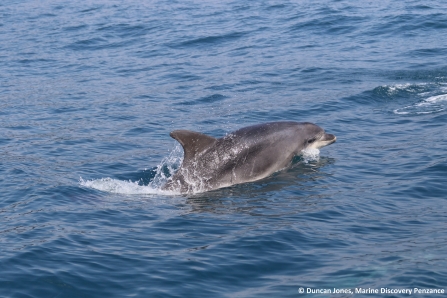
One of the South West's last remaining bottlenose dolphins. Photo: Duncan Jones
Following the past success of the South West Bottlenose Dolphin Consortium in collating the evidence to prove that there is a resident pod of bottlenose dolphins around SW England, scientists from the University of Plymouth are now helping to take the research forward in 2020 and are calling on the public to search through their photos and send in their records of these incredible animals.
We are lucky to have a plethora of wildlife in our waters around the SW coast including a resident pod of 28 bottlenose dolphins. Sadly, however, this pod is in serious threat of decline due to their low numbers, lack of statutory protection and increased vulnerability to disturbance owing to their proximity to human populations. To not only ensure the SW pod’s survival but for the pod to thrive the best scientific evidence is needed to both support and encourage conservation action.
The South West Bottlenose Dolphin Consortium, a partnership of stakeholders, including Devon Wildlife Trust, was set up in 2016 to gather the information needed for their protection. The consortium collated records and photos of bottlenose dolphin encounters from the general public, with reports coming from ferries, marine tour operators, charitable organisations and other interested parties. An amazing amount of information was gathered during this research, unfortunately highlighting that this small population is at severe risk of local extinction and that much more work was needed for their effective conservation.
The South West Bottlenose Dolphin Consortium is now working with the University of Plymouth researcher Shauna Corr to expand reporting and is calling on the public’s help to gather the information they need to track the pod’s movements throughout Cornwall, Devon, and Dorset.
Bottlenose dolphins can easily be recognised through their large sickle-shaped dorsal fins as the trailing edge is particularly susceptible to scratches and tears. This tissue rarely regenerates leaving permanent notches and markings which can be used to identify individuals much like our own fingerprints. Photographic encounters not only help identify individual animals but can also track their movements, preferred habitats and social networks. Historical sighting information from previous years is invaluable as it can be used to track the survival of individuals between years which means population trends can be monitored.
If you are looking for a fun activity to do whilst social distancing, there are three easy ways you can help to conserve this pod:
- Look through your old photos/videos and send in any sighting information you may have
- If out by the coast on your daily exercise or part of essential work, look out for this pod and report your sightings
- Spread the word!
Whilst it is encouraged to send in photos you may already have of bottlenose dolphins, we do not want to encourage trips to the coast unless it is already part of your usual exercise routine. We also would like to remind the public that it is an offence to deliberately disturb or harass a dolphin in its natural environment, keeping this in mind, photographers should keep their distance, allowing any encounter to be on an animal’s terms.
If you would like to become a citizen scientist and submit your encounters new or old please visit here for more
